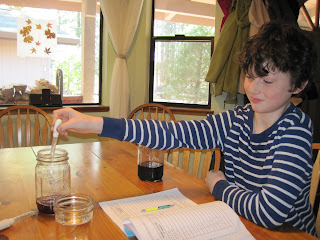A lot of people will argue, he's not really "reading" the stop sign. He's not actually decoding the print. He could not "read" the word in a different font, in a different location, if it was not on a red, octagon shaped sign. That is probably true, but that does not mean he is not reading it.
Reading is seeing print and getting meaning from it. Although a young child reading a stop sign is not "real" reading, it is certainly the beginning of real reading, and it is something that you can use to teach reading.
You can teach a lot of reading with just the stop sign. Using only a stop sign you can teach the following skills:
- letter versus word (early reading skills)
- capital versus lower case letters (alphabet)
- letter identification (alphabet)
- letter/sound connection (phonics)
- letter formation (writing)
- first letter and last letter (early reading skills)
- counting (math)
- reading left to right (early reading skills)

Here's how you teach your child to read using a stop sign:
First, start pointing out stop signs when you see them and say things like:
- Look, there is a stop sign!
- Do you see the stop sign?
- That sign says STOP.
- Do you know what that sign says?
Next, wait for your child to start pointing out the stop sign. Now you are ready to start to focus your child's attention on the details of the stop sign. When he says, "I see a stop sign!, you say something like:
- You're right, that sign says STOP.
- What color is the stop sign?
- Do you see the letters on the stop sign?
- The stop sing is an octagon shape, it has 8 sides.
Now you are ready to dig in deeper. This involves more than just a drive by. You can take a walk and stop and look at a stop sign up close. You can use copies of stop signs at home to take a closer look.
To teach letter versus word point to the word STOP and say:
- This is the word STOP.
- There are four letters in the word STOP: S, T, O, P (point out each letter)
To teach first letter, next letter, and last letter point to the letters and say:
- S is the first letter in the word STOP.
- P is the last letter in the word STOP.
 |
| Print and cut this puzzle to practice saying the letters, building the word, counting the letters and working left to right. |
Reading left to right can be shown to them by sliding your finger under the word STOP as you say the word slowly. Read the names of the letters, pointing to them as you say them S-T-O-P. After lots of modeling ask your child to read the word using their finger and to point and say the letters. If they have trouble matching one-to-one then hold their finger and guide them. As you are pointing to each letter and saying the name you are working on letter identification.
Get out letter tiles or magnetic letters and have them build the word stop. Make sure they always start with the letter S and build the word from left to right to reinforce the left to right movement in reading and writing.
This page can be used to trace the letters to practice letter formation, and then build the word with letter tiles or magnetic letters:
This page can be used to trace the letters to practice letter formation, and then build the word with letter tiles or magnetic letters:
You can practice writing the word stop to practice letter formation. Follow the directions for letter formation explained in The Name Game.
Counting:
- Count the letters in the word STOP. (You are also reinforcing letter versus word.)
- Count the sides of the sign.
Capital and lower case letters:
 |
| Print out the capital and lower case letter cards to use for letter identification, matching capital to lower case, and building the word stop. |
Show them that the word on the stop sign is written in all capital letters. Show them what it looks like with lower case letters.
 |
| We got out the letter tiles (Bananagrams) and matched them up to the letter cards. |
 |
| We made the word STOP with different letters. |
 |
| More letters to make the word STOP. |
 |
| How many different kinds of letters can you use to make the word STOP? |
Finally, the last page included in the STOP and learn to read printables is the size sequencing with numbers.
I had a plan to arrange the signs and the numbers on the pocket chart like this:
As often happens, my daughter had another idea about how to use the numbers 1-3. She quickly got another set of number cards from the pocket chart and matched them up:

Letter tiles, STOP and learn to read printables, Traffic sign printables. We made a mess, we had fun, we learned!
Continue with the fun with these great related FREE printables:
 |
| Memorizing the Moments: Traffic Signs Printables |
Click here to go to the free printables and blog post Traffic Sign Tot Pack from Memorizing the Moments
 |
| Enchanted Homeschooling: Truck Storybook Fun! |
Click here to go to the Truck Storybook Fun blog post and free printables. at Enchanted Homeschooling Mom.
 |
| 123 Homeschool 4 Me: Traffic Signs Preschool Pack |






































